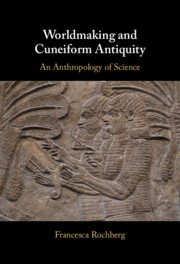Book contents
- Worldmaking and Cuneiform Antiquity
- Worldmaking and Cuneiform Antiquity
- Copyright page
- Dedication
- Epigraph
- Contents
- Figures
- Preface
- Acknowledgments
- Notes on Chronological and Typographical Conventions
- Glossary of Astronomical Terminology Cited
- Abbreviations
- Introduction
- Part I Historiography of Science
- Part II Worldmaking and the Anthropology of Science
- 4 The Idea of Worlds
- 5 Uses of Diversity
- 6 Worldmaking in Cuneiform Culture
- 7 Imago Mundi
- Conclusion
- References
- Index of Names and Subjects
5 - Uses of Diversity
from Part II - Worldmaking and the Anthropology of Science
Published online by Cambridge University Press: 09 January 2025
- Worldmaking and Cuneiform Antiquity
- Worldmaking and Cuneiform Antiquity
- Copyright page
- Dedication
- Epigraph
- Contents
- Figures
- Preface
- Acknowledgments
- Notes on Chronological and Typographical Conventions
- Glossary of Astronomical Terminology Cited
- Abbreviations
- Introduction
- Part I Historiography of Science
- Part II Worldmaking and the Anthropology of Science
- 4 The Idea of Worlds
- 5 Uses of Diversity
- 6 Worldmaking in Cuneiform Culture
- 7 Imago Mundi
- Conclusion
- References
- Index of Names and Subjects
Summary
Chapter 5 is framed by issues of cultural, epistemological, and ontological likeness, difference, and pluralism at the heart of anthropology. It brings these ideas to bear on cuneiform intellectuals’ vehicles of worldmaking through their classification of things and their particular form of astronomical model-making.
- Type
- Chapter
- Information
- Worldmaking and Cuneiform AntiquityAn Anthropology of Science, pp. 133 - 167Publisher: Cambridge University PressPrint publication year: 2025

